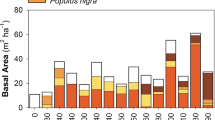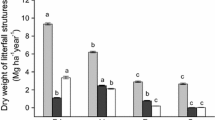Abstract
We assess the hypothesis that rates of nitrogen transformations in the soil are altered upon replacement of native by exotic trees, differing in litter properties. Ailanthus altissima and Robinia pseudoacacia, two common exotic trees naturalized in the Iberian Peninsula, were compared with the native trees Ulmus minor and Fraxinus angustifolia, respectively. Naturally senesced leaves of each species were collected and C:N ratio, N and lignin content assessed. We prepared 64 litter bags per species and left them to decompose, below the canopy of the same species and below the canopy of the paired species. Dry mass, N concentration and N pool of the remaining litter were assessed after 5 and 7 months. Soil samples were collected three times during the experiment to assess soil moisture, organic matter, pH, potential mineralization rates and mineral N pools. Mineral N availability was assessed three times in the field by using ion-exchange resin-impregnated membranes. Ailanthus litter decomposed faster than Ulmus litter, probably due to the higher toughness of the latter. In spite of its high N content, Robinia litter decomposed slower than Fraxinus one, probably due to its high lignin content. In both cases, litter decomposition was faster below the exotic than the native canopies. The release of N per unit of initial litter mass was higher under both invaded situations (Ailanthus below Ailanthus and Robinia below Robinia) than under the native ones. However, soils collected below native and exotic trees neither differed in potential N mineralization rate nor in mineral N. This may be attributed to a quick plant uptake of released N and/or to a high organic matter accumulation in the soil previous to invasion that can exert a tighter control on soil N transformations than the current exotic litter.




Similar content being viewed by others
References
Abrams MM, Jarrell WM (1992) Bioavailability index for phosphorus using ion exchange resin impregnated membranes. Soil Sci Am J 56:1532–1537
Aerts R, Chapin FSIII (2000) The mineral nutrition of wild plants revisited: a re-evaluation of processes and patterns. Adv Ecol Res 30:1–67. doi:10.1016/S0065-2504(08)60016-1
Baron JS, Poff NL, Angermeier PL, Dahm CN, Gleick PH, Hairston NG et al (2002) Meeting ecological and societal needs for freshwater. Ecol Appl 12:1247–1260. doi:10.1890/1051-0761(2002)012[1247:MEASNF]2.0.CO;2
Baruch Z, Bilbao B (1999) Effects of fire and defoliation on the life history of native and invader C-4 grasses in a Neotropical savanna. Oecologia 119:510–520. doi:10.1007/s004420050814
Bauer Manderscheid E (1980) Los montes de España en la historia. Ministerio de Agricultura, Madrid, p 613
Berendse F, Bobbink R, Rouwenhorst G (1989) A comparative-study on nutrient cycling in wet heathland ecosystems. 2. litter decomposition and nutrient mineralization. Oecologia 78:338–348. doi:10.1007/BF00379107
Berg B (1984) Decomposition of root litter and some factors regulating the process—long-term root litter decomposition in a scots pine forest. Soil Biol Biochem 16:609–617. doi:10.1016/0038-0717(84)90081-6
Boring LR, Swank WT (1984) The role of black locust (Robinia pseudoacacia) in forest succession. J Ecol 72:749–766. doi:10.2307/2259529
Bowman WD, Theodose TA, Schardt JC, Conant RT (1993) Constraints of nutrient availability on primary production in 2 Alpine Tundra communities. Ecology 74:2085–2097. doi:10.2307/1940854
Carpenter SR, Caraco NF, Correll DL, Howarth RW, Sharpley AN, Smith VH (1998) Nonpoint pollution of surface waters with phosphorus and nitrogen. Ecol Appl 8:559–568. doi:10.1890/1051-0761(1998)008[0559:NPOSWW]2.0.CO;2
Chapin FS, Walker BH, Hobbs RJ, Hooper DU, Lawton JH, Sala OE et al (1997) Biotic control over the functioning of ecosystems. Science 277:500–504. doi:10.1126/science.277.5325.500
Choong MF, Lucas PW, Ong JSY, Pereira B, Tan HTW, Turner IM (1992) Leaf fracture toughness and sclerophylly: their correlation and ecological implications. New Phytol 121:597–610. doi:10.1111/j.1469-8137.1992.tb01131.x
Chytrý M, Pysek P, Wild J, Pino J, Maskell LC, Vilà M (2008) European map of alien plant invasions based on the quantitative assessment across habitats. Divers Distrib. doi:10.1111/j.1472-4642.2008.00515.x
Cornelissen JHC, Thompson K (1997) Functional leaf attributes predict litter decomposition rate in herbaceous plants. New Phytol 135:109–114. doi:10.1046/j.1469-8137.1997.00628.x
Cornelissen JHC, Pérez-Harguindeguy N, Díaz S, Grime JP, Marzano B, Cabido M et al (1999) Leaf structure and defense control litter decomposition rate across species and life forms in regional floras on two continents. New Phytol 143:191–200. doi:10.1046/j.1469-8137.1999.00430.x
Correll DL (1997) Buffer zones and water quality protection: general principles. In: Haycock NE, Burt TP, Goulding KWT, Pinay G (eds) Buffer zones: their processes and potential in water protection. Quest Environmental, Harpendon, UK, pp 7–20
Evans RD, Rimer R, Sperry L, Belnap J (2001) Exotic plant invasion alters nitrogen dynamics in an arid grassland. Ecol Appl 11:1301–1310. doi:10.1890/1051-0761(2001)011[1301:EPIAND]2.0.CO;2
Gallardo A, Merino J (1992) Nitrogen immobilization in leaf litter at two Mediterranean ecosystems of SW Spain. Biogeochemistry 15:213–228. doi:10.1007/BF00002937
Gallardo A, Merino J (1993) Leaf decomposition in two Mediterranean ecosystems of southwest Spain: influence of substrate quality. Ecology 74:152–161. doi:10.2307/1939510
Grotkopp E, Rejmánek M (2007) High seedling relative growth rate and specific leaf area are traits of invasive species: phylogenetically independent contrasts of woody angiosperms. Am J Bot 94:526–532. doi:10.3732/ajb.94.4.526
Guerra A and Monturiol F (1970) Memoria explicativa del mapa provincial de suelos de Guadalajara. Escala 1:250.000. CSIC
Hattenschwiler S, Vitousek PM (2000) The role of polyphenols in terrestrial ecosystem nutrient cycling. Trends Ecol Evol 15:238–243. doi:10.1016/S0169-5347(00)01861-9
Haubensak KA, D’Antonio CM, Alexander J (2004) Effects of nitrogen-fixing shrubs in Washington and coastal California. Weed Technol 18:1475–1479
Hawkes CV, Wren IF, Herman DJ, Firestone MK (2005) Plant invasion alters nitrogen cycling by modifying the soil nitrifying community. Ecol Lett 8:976–985. doi:10.1111/j.1461-0248.2005.00802.x
Heisey RM, Heisey TK (2003) Herbicidal effects under field conditions of Ailanthus altissima bark extract, which contains ailanthone. Plant Soil 256:85–99. doi:10.1023/A:1026209614161
Hendershot WH, Lalande H, Duquette M (1993) Soil reaction and exchangeable acidity. In: Carter MR (ed) Soil sampling and methods of analysis. Lewis publishers, Boca Raton, p 384
Hooper DU, Vitousek PM (1998) Effects of plant composition and diversity on nutrient cycling. Ecol Monogr 68:121–149
Kolar CS, Lodge DM (2001) Progress in invassion biology: predicting invaders. Trends Ecol Evol 16:199–204. doi:10.1016/S0169-5347(01)02101-2
Kowarik I, Saumel I (2007) Biological flora of central Europe: Ailanthus altissima (Mill.) swingle. Perspect Plant Ecol Evol Syst 8:207–237. doi:10.1016/j.ppees.2007.03.002
Lake JC, Leishman MR (2004) Invasion success of exotic plants in natural ecosystems: the role of disturbance, plant attributes and freedom from herbivores. Biol Conserv 117:215–226. doi:10.1016/S0006-3207(03)00294-5
Le Maitre DC, van Wilgen BW, Chapman RA, McKelly DH (1996) Invasive plants and water resources in the Western Cape Province, South Africa: modeling the consequences of a lack of management. J Appl Ecol 33:161–172. doi:10.2307/2405025
Levine JM, Vila M, D’Antonio CM, Dukes JS, Grigulis K, Lavorel S (2003) Mechanisms underlying the impacts of exotic plant invasions. Proc R Soc Lond Biol 270:775–781. doi:10.1098/rspb.2003.2327
Mack RN (2003) Phylogenetic constraint, absent life forms, and preadapted alien plants: a prescription for biological invasions. Int J Plant Sci 164:S183–S196. doi:10.1086/368399
Mack MC, D’Antonio CM, Ley RE (2001) Alteration of ecosystem nitrogen dynamics by exotic plants: a case study of C4 grasses in Hawaii. Ecol Appl 11:1323–1335
Mitrakos KA (1980) A theory for Mediterranean plant life. Acta Oecol 1:245–252
Monturiol F, Alcalá L (1990) Mapa de Asociaciones de suelos de la Comunidad de Madrid. Escala 1:200.000. CSIC y Comunidad de Madrid
Pattison RR, Goldstein G, Ares A (1998) Growth, biomass allocation and photosynthesis of invasive and native Hawaiian rainforest species. Oecologia 117:449–459. doi:10.1007/s004420050680
Porta Casanellas J, López-Acevedo Reguerín M, Rodríguez Ochoa R (1982) Técnicas y Experimentos en Edafología. Colegio Oficial de Ingenieros Agrónomos de Cataluña
Prescott CE, Corbin JP, Parkinson D (1992) Immobilization and availability of N and P in the forest floors of fertilized rocky-mountain coniferous forests. Plant Soil 143:1–10. doi:10.1007/BF00009123
Quested HM, Callaghan TV, Cornelissen JHC, Press MC (2005) The impact of hemiparasitic plant litter on decomposition: direct, seasonal and litter mixing effects. J Ecol 93:87–98. doi:10.1111/j.0022-0477.2004.00951.x
Sanz Elorza M, Dana Sánchez ED, Sobrino Vesperinas E (2004) Atlas de las plantas alóctonas invasoras en España. Dirección General para la Biodiversidad. Ministerio de Medio Ambiente, Madrid, p 384
Schlesinger WC (1991) Biogeochemistry. Academic Press, New York, USA
Sims GK, Ellsworth TR, Mulvaney RL (1995) Microscale determination of inorganic nitrogen in water and soil extracts. Commun Soil Sci Plant Anal 26:303–316
Solla A, Bohnens J, Collin E, Diamandis S, Franke A, Gil L et al (2005) Screening European elms for resistance to Ophiostoma novo-ulmi. For Sci 51:134–141
Soudzilovskaia NA, Onipchenko VG (2005) Experimental investigation of fertilization and irrigation effects on an alpine heath, northwestern Caucasus, Russia. Arct Antarct Alp Res 37:602–610. doi:10.1657/1523-0430(2005)037[0602:EIOFAI]2.0.CO;2
Sparling G, Whale K, Ramsay A (1985) Quantifying the contribution from the soil microbial biomass to the extractable P levels of fresh and air-dried soils. Aust J Soil Res 23:613–621. doi:10.1071/SR9850613
Stock WD, Wienand KT, Baker AC (1995) Impacts of Invading N-2-fixing Acacia species on patterns of nutrient cycling in 2 cape ecosystems—evidence from soil incubation studies and N-15 natural-abundance values. Oecologia 101:375–382. doi:10.1007/BF00328825
Subler S, Blair JM, Edwards CA (1995) Using anion-exchange membranes to measure soil nitrate availability and net nitrification. Soil Biol Biochem 27:911–917. doi:10.1016/0038-0717(95)00008-3
Tateno R, Tokuchi N, Yamanaka N, Du S, Otsuki K, Shimamura T, Xue ZD, Wang SQ, Hou QC (2007) Comparison of litterfall production and leaf litter decomposition between an exotic black locust plantation and an indigenous oak forest near Yan’an on the Loess Plateau, China. For Ecol Manage 241:84–90
Taylor BR, Parkinson D, Parsons WFJ (1989) Nitrogen and lignin content as predictors of litter decay-rates—a microcosm test. Ecology 70:97–104. doi:10.2307/1938416
Uselman SM, Qualls RG, Thomas RB (1999) A test of a potential short cut in the nitrogen cycle: the role of exudation of symbiotically fixed nitrogen from the roots of a N-fixing tree and the effects of increased atmospheric CO2 and temperature. Plant Soil 210:21–32. doi:10.1023/A:1004619509878
Vilà M, Tessier M, Suehs CM, Brundu G, Carta L, Galanidis A et al (2006) Local and regional assessment of the impacts of plant invaders on vegetation structure and soil properties of Mediterranean islands. J Biogeography 33:853–861. doi:10.1111/j.1365-2699.2005.01430.x
Vitousek PM, Walker LR (1989) Biological invasion by Myrica faya in Hawaii: plant demography, nutrient fixation, ecosystem effects. Ecol Monogr 59:247–265. doi:10.2307/1942601
Xiong YM, Xia HX, Li ZA, Cai XA, Fu SL (2008) Impacts of litter and understory removal on soil properties in a subtropical Acacia mangium plantation in China. Plant Soil 304:179–188. doi:10.1007/s11104-007-9536-6
Yelenik SG, Stock WD, Richardson DM (2004) Ecosystem level impacts of invasive Acacia saligna in the South African fynbos. Restor Ecol 12:44–51. doi:10.1111/j.1061-2971.2004.00289.x
Yelenik SG, Stock WD, Richardson DM (2007) Functional group identity does not predict invader impacts: differential effects of nitrogen-fixing exotic plants on ecosystem function. Biol Invasions 9:117–125
Acknowledgments
We want to acknowledge Dr. Melchor Maestro for analyzing lignin and C:N ratios of leaf material, Dr. Asunción Saldaña for her help with soil classification, the Botanical Garden “Juan Carlos I” of Alcalá University, and Alcalá Natura/El Encín for allowing us to perform part of the experiments in their dependencies. The Spanish Meteorological National Service kindly provided climatic data. Dr. JHC Cornelissen and the scientific staff of the Unit of Forest Ecology and Forest Management (Wageningen University) made useful comments during the redaction of the manuscript. This study was supported by the grant CGL2007-61873/BOS of the Spanish Ministry of Education and Science. PCD was sponsored by UAH grant for her stay at Wageningen University. LP was supported by a fellowship from the Wageningen Graduate School Production Ecology and Resource Conservation. We are grateful to the support of the REMEDINAL network (Comunidad de Madrid).
Author information
Authors and Affiliations
Corresponding author
Rights and permissions
About this article
Cite this article
Castro-Díez, P., González-Muñoz, N., Alonso, A. et al. Effects of exotic invasive trees on nitrogen cycling: a case study in Central Spain. Biol Invasions 11, 1973–1986 (2009). https://doi.org/10.1007/s10530-008-9374-3
Received:
Accepted:
Published:
Issue Date:
DOI: https://doi.org/10.1007/s10530-008-9374-3




